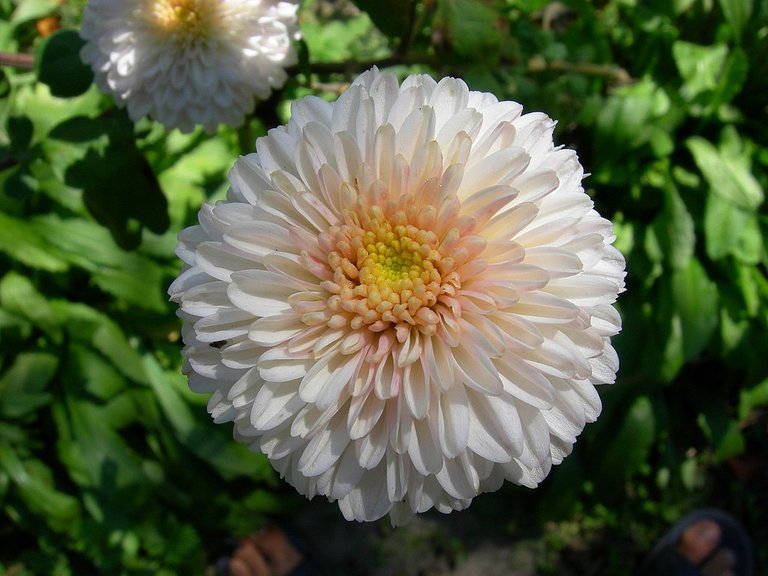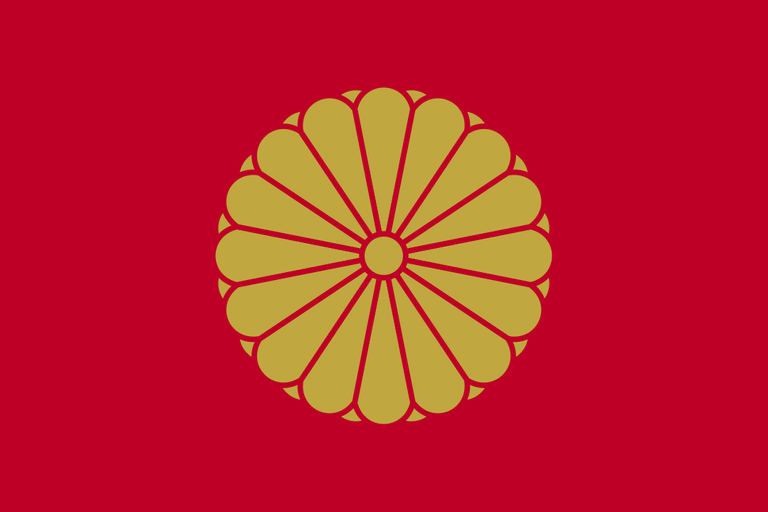
[ENG]
Welcome to the Mid-month Special edition of the Mizu no Oto haiku contest!
We are inaugurating this special formula to encompass all the Mizu No Oto initiatives that will go beyond the usual haiku contest. These initiatives will be published in the middle of each month, while on the first of the month there will be a regular edition of Mizu No Oto.
This time, after seeing that you very much appreciated the renga experiment we did to celebrate the 50th edition, we decided to repeat it, with a particular theme.
The theme for the autumn renga is CHRYSANTHEMUM, the symbolic flower of Japan, whose beauty is celebrated every year by the Emperor who, on the occasion of its flowering, opens the palace gardens to the public, presenting the latest varieties to all the guests.

(pic by Aleksei Belta under CC license)
This flower is a solar symbol connected to the imperial dynasty of Japan, whose members proclaim their ancestry from the sun goddess Amaterasu herself.
For this reason, the Japanese imperial office is also called the Chrysanthemum Throne.

The imperial banner of Japan, featuring a golden chrysanthemum with sixteen petals
Every September 9th, the ninth day of the ninth month, Kiku no sekku (菊 の 節 句) is held, literally Chrysanthemum Festival.
During this festival, each participant exhibits the chrysanthemums they have grown, making the autumn streets bloom.
According to popular tradition, the dew that forms on chrysanthemums the night before the festival has healing powers.
In Italy, however, the chrysanthemum is the flower offered to the deceased for the November 2nd memorial holiday, because it is one of the few to bloom this season. For this reason, it is a flower connected to the dead and to funereal values.
[ES]
¡Bienvenido a la Edición especial de mitad de mes del concurso de haiku Mizu no Oto!
Inauguramos esta fórmula especial para englobar todas las iniciativas de Mizu No Oto que irán más allá del habitual concurso de haiku. Estas iniciativas se publicarán a mediados de cada mes, mientras que el primero de mes habrá una edición regular de Mizu No Oto.
Esta vez, después de ver que apreciabas mucho el experimento renga que hicimos para celebrar la 50ª edición, decidimos repetirlo, con un tema en particular.
El tema del renga otoñal es el CRISANTEMO, la flor simbólica de Japón, cuya belleza celebra cada año el Emperador que, en ocasión de su floración, abre al público los jardines del palacio, presentando las últimas variedades a todos los invitados.
Esta flor es un símbolo solar relacionado con la dinastía imperial de Japón, cuyos miembros proclaman su ascendencia de la diosa del sol Amaterasu en persona.
Por esta razón, la oficina imperial japonesa también se llama Trono del Crisantemo.
El estandarte imperial de Japón, presenta un crisantemo dorado con dieciséis pétalos.
Cada 9 de septiembre, el noveno día del noveno mes, se lleva a cabo Kiku no sekku (菊 の 節 句), literalmente Festival del Crisantemo.
Durante este festival, cada participante exhibe los crisantemos que han cultivado, haciendo florecer las calles otoñales.
Según la tradición popular, el rocío que se forma en los crisantemos la noche anterior a la fiesta tiene poderes curativos.
En Italia, sin embargo, el crisantemo es la flor que se ofrece a los difuntos para la festividad conmemorativa del 2 de noviembre, porque es una de las pocas que florece en esta temporada. Por eso, es una flor ligada a los muertos y valores funerarios.

[ES]
Así es como funciona este concurso:
Reserven su orden de participación comentando (Primero, segundo, tercero, etc...).
Usted escribe un haiku inspirado en el haiku del participante que se ha reservado antes, con su propia publicación (use #haikucontest como una de su etiquetas y, si quiere, publique en Bananafish community tambien).
El primer participante escriberà un haiku ispirado por el haiku del prompt que publicamos.
El renga termina cuando no se añaden otros participantes, así que corre la voz!
Cada participante recibirá 1 Hive SBI!
[ENG]
Here is how this contest works:
Book your order of participation commenting (First, second, third, etc ...).
You write a haiku inspired by the participant's haiku that was booked before, with your own post (use #haikucontest as one of your tags and, if you want, post to Bananafish community too).
The first participant will write a haiku inspired by the prompt haiku published here.
The renga ends when no other participant add, so spread the word!
Each participant will receive 1 Hive SBI!

Los requisitos / The requirements:
• Un haiku no tiene título / A haiku has no title.
• Idiomas permitidos: inglés o español / Allowed languages: English or Spanish.
• La forma del haiku en español que preferimos en este contest es: un verso de 5 sílabas, un verso de 7 sílabas, otro verso de 5 sílabas; se permiten sinalefa y el conteo métrico de las sílabas.
• The English haiku form preferred for this contest is: a short (3-4 syllable) verse, a longer (5-6 syllable) verse, another short (3-4 syllable) verse.
• Debe haber el kireji (切 れ 字), un corte entre los versos primero y segundo, o entre el segundo y el tercero; el corte puede ser gramatical, como un signo de puntuación, o puede ser un corte en el significado, como dos imágenes en contraste / There should be the kireji (切れ字), a cut between the 1st and the 2nd verses, or between the 2nd and the 3rd; the cut can be grammatical, as a sign of punctuation, or it can be a cut in the meaning, like two different images.

Start from here / Comienza desde aquí:
October dawn -
petals in the mist
beyond the gate
*
alba de octubre -
pétalos en la niebla
través del umbral

Main aesthetic characteristics of a good haiku / Principales características estéticas de un buen haiku:
• Kigo (季語), an explicit or implicit reference to a season, that defines the time of the year in which the haiku is composed or referred to / una referencia explícita o implícita a una temporada, que define la época del año en que se compone o hace referencia al haiku.
• Sabi (寂), the sense of the inexorable passage of time, the beauty or serenity that accompanies the advance of age, when the life of the objects and its impermanence are highlighted by patina and wear or by any visible repairs / el sentido del inexorable paso del tiempo, la belleza o la serenidad que acompañan al avance de la edad, cuando la vida de los objetos y su impermanencia se destacan por la pátina y el desgaste o por cualquier reparación visible.
• Wabi (侘寂), the taste for frugal and natural things, rustic simplicity, freshness or silence; it can be applied to both natural and artificial objects, or even non-ostentatious elegance / el gusto por las cosas frugales y naturales, la sencillez rústica, la frescura o el silencio; puede aplicarse tanto a objetos naturales como artificiales, o incluso a la elegancia no ostentosa.
• Mono no aware (物の哀れ), empathy with nature and human life; the "feeling of things", nostalgia, regret for the passing of time, understanding of the changeability and of the transience without suffering / empatía con la naturaleza y la vida humana; el "sentimiento de las cosas", la nostalgia, el arrepentimiento por el paso del tiempo, la comprensión del cambio y la transitoriedad sin sufrimiento.
• Yūgen (幽玄), sense of wonder and mystery; it represents the state of mind produced by the inexplicable fascination of things, the feeling of an 'other' universe, full of mysterious unity / sentido de maravilla y misterio; representa el estado mental producido por la inexplicable fascinación de las cosas, el sentimiento de un "otro" universo, lleno de misteriosa unidad.
• Karumi (軽み), beauty in simplicity; poetic beauty reflected in its simplicity, free from preconceptions and moral judgment / belleza en simplicidad; La belleza poética se refleja en su simplicidad, libre de preconcepciones y juicios morales.
• Shiori (しおり), gentleness; the levity and the delicate charm that radiates from the verses, where things are evoked in the reader without aggressiveness or excessive explicitness / gentileza; la ligereza y el delicado encanto que irradia de los versos, donde las cosas se evocan en el lector sin agresividad ni excesiva explicación.

I call together the most enthusiastic haiku authors of the Bananafish Tribe / Convoco a los autores de haiku más entusiastas de la tribu Bananafish:
@f3nix, @manoldonchev, @kaonashi6686, @owasco, @gabmr, @mllg, @gracielaacevedo, @sacra97, @josegilberto, @evagavilan2, @wolffeys, @josemalavem, @adncabrera, @felixgarciap, @tristancarax, @sayury, @oscarina, @jacobtothe, @marcybetancourt, @petronila, @alejandroxg, @yolimarag, @yujomar, @naylet, @oacevedo, @aurodivys, @salvao, @gwilberiol, @solperez, @qwerrie, @johannfrare, @letalis-laetitia
Good haiku to everybody! / Buen haiku para todos!

Let’s the Bananafish Tribe grow together!

With delegations, Bananafish voting power will grow and consequently the upvotes given to every contest entry will be higher. An easy mode to delegate some of your HP for a gigantic energy wave is to use PeakD and its wallet.
Following the curation trail is a way to make sure you always support the other participants to the Bananafish contests, automatically upvoting the posts (but not the comments) that Bananafish upvotes. We suggest to join hive.vote to follow curation trails or create yours.
We are also happy if you join the official Hive Bananafish community and publish the posts related to the contest within it, as well as in your blog
Join the Bananafish Realms on Discord and chat with us: https://discord.gg/ZWmEUWT

[banner credit: @f3nix]
Un gran agradecimiento a todos los que participaron en este renga: @josemalavem, @sacra97, @gracielaacevedo, @marcybetancourt, @darruiz, @adncabrera, @evagavilan2, @sayury, @yolimarag, @oacevedo,
Su haiku iluminan los días agotadores que estoy atravesando. Pronto comentaré sobre todos y escribiré la publicaciòn final.
Escribí este comentario porque no quería dejarlos sin una palabra, esperando tiempo para hacer todo lo demás. 😄
¡Muchas gracias, @marcoriccardi!
Es una bella actividad de diálogo y de apreciación colectiva de la belleza. ¡Al final cada quien mostró un crisantemo de su jardín!
Agradecida con las palabras doradas de aliento, a veces no sabemos las dificultades de otros. Esta es una hermosa actividad sacando lo mejor de cada uno. Ánimo todo esto pasará @marcoriccardi
Gracias @marcoriccardi por tus palabras. Este tiempo se torna extraño. Pronto, espero que muy pronto, podamos salir del agotamiento abrumador que nos agobia. Fuerte abrazo desde Venezuela y mil gracias por el ejercicio poético de la Renga.
Hola, @marcoriccardi. Motivadora propuesta. Me anoto para ser el que continúe el prompt (primero). Saludos.
Saludos, amigos. Cumpliendo con lo solicitado, aquí dejo el enlace de mi post y copio el ejercicio en español que trata de continuar el prompt.
https://peakd.com/hive-169028/@josemalavem/mi-participacion-en-mizu-no-oto-every-image-has-its-haiku-mid-month-special-renga-english-espanol
fragancia sutil
blanco que nos cautiva
el día brilla
Tan rapido! Quien serà el segundo?
How fast! Who will be the second?
El tiempo apremia, y hay que atender otras tareas. Esperemos que pronto respondan. Saludos.
Sigo de segunda pido el turno @bananafish
Saludos amigos @bananafish
https://hive.blog/hive-169028/@sacra97/mi-participacion-en-mizu-no-oto-every-image-has-its-haiku-mid-month-special-renga-english-espanol
II segunda
dorados rayos
apretujé pétalos
entre cuadernos
Saludos amantes del haiku.
Con mucha alegría, agradecida por la convocatoria de @bananafish dejo mi participación en este encuentro:
Pétalos del sol.
La tierra está llena
de bellos olores.
Petals of the sun.
The earth is full
of beautiful smells.
Hooooola amigos @bananafish, feliz de llegar a tiempo en esta convocatoria. Cuarta Participante. https://hive.blog/hive-169028/@marcybetancourt/mizu-no-oto-every-image-has-its-haiku-mid-month-special-renga-english-espanol
concéntrica formación -
octubre floral
Voy de Quinto
Halo Perfecto
Geometría Pura
Sereno y Paz.
Hola!
Voy de sexta.
Esperando al amigo @darruiz.
Mi Participación
Halo Perfecto
Geometría Pura
Sereno y Paz.
Bellísimo @darruiz. Disculpa mi respuesta tardía. He tenido montón de problemas técnicos y domésticos, de horario y de contingencias. Cuando venga el apocalipsis zombi me encontrará entrenada:
Abre la flor.
Hacen ronda de luz
los diez mil pétalos
Disculpas a todos por la espera!
Tranquila. También he tenido esos problemas técnicos. Me parece que tu haiku se incorpora muy bien con el último que es de @oacevedo
No te preocupes! Tu haiku serà incluido en el renga, ademàs esta muy valioso!
Hola @bananafish y queridos amigos de Mizu No Oto.
Tengo el mío preparado pero no puedo publicar. esperaré hasta que lo haga @adncabrera y sigo yo.
Debido a los problemas de actualización de Hive no había podido publicar. Al fin he podido lograrlo. Aquí dejo mi participación después de @darruiz.
https://peakd.com/hive-169028/@evagavilan2/mizu-no-oto-every-image-has-its-haiku-mid-month-special-renga-english-espanol
Para cada uno
pétalos o lágrimas.
Metamorfosis
Mi participación, después de @evagavilan2 :
delicado matiz.
Reina el color
Mi post: https://hive.blog/hive-169028/@sayury/mizu-no-oto-every-image-has-its-haiku-mid-month-special-renga-english-espanol
Saludos a todos, compañeros y amigos.
Me ha correspondido escribir el décimo haiku, después del de @yolimarag.
Esta es mi participación:
https://hive.blog/hive-169028/@oacevedo/mizu-no-oto-every-image-has-its-haiku-mid-month-special-renga-english-espanol
Pétalos, aves.
Sol de pura pasión
inmaculada.
Saludos, amigos, vengo después de @oacevedo si aun hay tiempo. He tenido muchos problemas con mi conexión de internet. Voy a publicar y regreso
The renga is still going on...I dont' want to stop it! I really like collective poetry, reading every little fragment that stretches the chain I feel a great emotion. How about letting it continue until it naturally stops by itself?
In next week's Mizu no Oto I will include the complete series up to that point.
El renga todavía está en marcha ... ¡No quiero detenerlo! Me gusta mucho la poesía colectiva, leyendo cada pequeño fragmento que estira la cadena siento una gran emoción. ¿Qué tal dejar que continúe hasta que se detenga naturalmente por sí solo?
En el Mizu no Oto de la próxima semana incluiré la serie completa hasta ese momento.